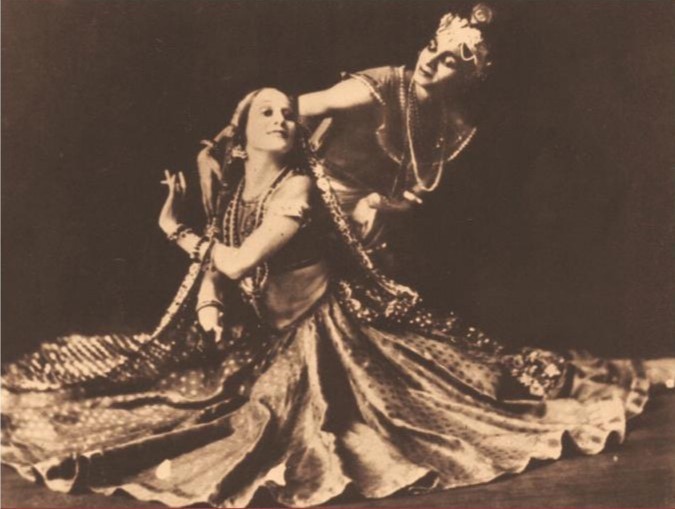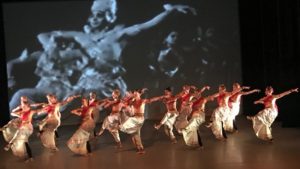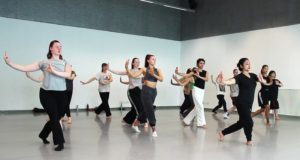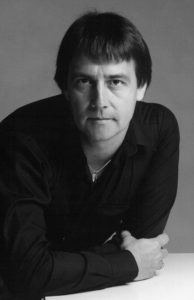Dancing the Past: The relevance of Kartikeya, Sacre du printemps and Ecstasy of Rita Joe - Vancouver Ballet Society
- Home
- Features 2020 - 2023
- Dancing the Past: The relevance of Kartikeya, Sacre du printemps and Ecstasy of Rita Joe

By Rebecca Karpus
Historical dance works are not nearly as accessible as paintings and music from the past, which are reasonably easy to access through art galleries, inexpensive reproductions, sheet music, and audio files. Beyond the rare film record and fleeting remounts onstage, where does dance of the past live? How do dancers and audiences keep in touch with historical choreographic works today?
Protima Chatterjee explores these questions through her work at Abundant Art, a London-based organization devoted to the preservation of artistic heritage through performances, publications, and workshops. As founder and creative director since 2017, Chatterjee brings her expertise as a dancer and educator to each project, including a recent one that brought together Uday Shankar (1900-1977) and Anna Pavlova (1881-1931).

Shankar was an Indian dancer and choreographer known, says Chatterjee, for “giving India its first contemporary dance format,” blending different traditional and contemporary styles and influences, including what he learned from Pavlova. Shankar met the high-profile Russian ballerina in London; she took an immediate interest in his budding dance practice and suggested the two work together. In 1923, they shared an evening titled Oriental Expressions at the Royal Opera House, which included a collaboratively choreographed piece with Pavlova appearing as Radha and Shankar as Krishna. An acclaimed tour in the United States followed. At that time, a collaboration between an Indian dancer and a ballet dancer was unheard of and these novel performances launched Shankar’s career.
Chatterjee, who grew up learning Shankar’s style of dance in India from members of his family (including his wife Amala Shankar), has always been fascinated with this history. Determined to learn more, she initiated the heritage project in 2018. The project includes a documentary film, A Meeting of Cultures, written and directed by Chatterjee; an extensive workshop series for all ages and backgrounds; and the recreation of one of Shankar’s works for performance.

Trinity Laban Conservatoire of Music and Dance accepted Chatterjee’s proposal for the second year BA Dance students’ historical project — a remount of Shankar’s Kartikeya as seen in his 1948 film, Kalpana. Chatterjee and Tanushree Shankar (Uday Shankar’s daughter-in-law) led the students through the choreography. Lecture series and technique classes specific to Uday Shankar enriched their experience.
It was the first time most of the students had worked in any style of Indian dance, and Chatterjee was inspired by their tenacity and curiosity. “Different bodies speak differently, so when I’m teaching [a movement] to somebody who has never done it before,” she says, “the response that I get from their body makes it a new kind of movement. That’s the thrill and the joy of sharing it.”

Chatterjee felt it was important for students to appreciate Pavlova’s collaborative spirit, to understand that ballet does not have to be rigid in its influences and aesthetics. She believes Pavlova exemplifies the idea that “dance practice is not linear. There are lots of elements, inspirations, and motivations that we can draw from other cultures, from other dance styles, which can come together — that is what makes your own artistic practice rich.”
As part of their studies, dance students learn Labanotation (Trinity Laban is partly named after Rudolf Laban, the method’s creator), and some attempted to notate Kartikeya. If there is continued interest and the resources to create a full Laban score, this could prove an invaluable tool, alongside the 1948 film footage, for future remounts of Kartikeya.
Canadian dancer Kirsten Wicklund can attest to the value of having both in-person stagers and video footage in a historical remount process. Both were important to Ballet Vlaanderen (Royal Ballet of Flanders) when the company remounted Pina Bausch’s 1975 Le Sacre du printemps (The Rite of Spring) in February 2022, in which Wicklund danced. Set to the powerful music of Igor Stravinsky, the version by Bausch — the iconic German choreographer (1940-2009) known for her fusion of dance and theatre, or tanztheater — takes inspiration from pagan rituals explored in the original 1913 Vaslav Nijinsky ballet.

For Wicklund, one of the most meaningful moments during the remount process was watching rarely seen video clips of Bausch herself, cigarette in mouth and dress pants tucked into rain boots, showing and describing the original movement. Wicklund felt these clips brought her as close to the choreography as possible with minute details picked up through hearing Bausch’s tone of voice and by interpreting her body language. Since video recording is readily available today, perhaps more focus should be given to creating these kinds of rich rehearsal clips for future generations.
Four stagers from different generations who had danced Bausch’s Le Sacre were involved, which offered diversity in the way the movement was taught. While they brought their own approach and perspective, they each embodied the movement impeccably, Wicklund recalls, and she appreciated the immense care they showed for Bausch’s work. Even with all this expertise, the movement was not easy to learn, as it was extremely specific in both physicality and intent.
Another layer of complexity came from the stage design: the work uses dirt on the stage (the stagers referred to it as “the earth”), which made the grounded movement more difficult to execute.
Wicklund came to realize the high level of specificity required to fully pass the choreography forward. Given that today’s dancers have different training and influences than dancers in the 1970s, when the work premiered, it was vital to prescribe the identical movement, ensuring that each future generation does not push the work further away from its original world. There was something beautiful, Wicklund says, about “keeping it in the world Bausch was working in.”
Dancers can also accumulate an immense amount of knowledge about a piece if they are lucky enough to encounter it firsthand throughout their career. This was the case for Tara Birtwhistle of the Royal Winnipeg Ballet with the 1971 The Ecstasy of Rita Joe by Canadian choreographer Norbert Vesak (1936-1990). After 20 years dancing with the company, transitioning to ballet master, and now serving as associate artistic director, Birtwhistle has developed a strong relationship with Vesak’s ballet. She first saw it onstage in 1987, and chose to dance the title role for her farewell performance upon retiring as a principal dancer.

The Ecstasy of Rita Joe, based on the 1967 play by George Ryga, was commissioned by the Manitoba Indian Brotherhood to mark the centenary of the signing of Indian Treaties Numbers 1 and 2. The ballet shed light on the damaging treatment of Indigenous people in Canada and painted a shocking picture of the current state of Indigenous life due to colonialism. With its multimedia elements and compelling storytelling — the title character is a young First Nations woman who struggles to adapt to life in the city after leaving her home on the reservation — The Ecstasy of Rita Joe became one of the RWB’s most sought-after ballets, with six local runs between 1971-2011, 93 tour performances worldwide, and a 1974 CBC film.
Birtwhistle compares the remount process of a historical ballet to the retelling of a story — the more times it gets shared and the more people who share it, the more likely it is to waver from the truth. Therefore, she considers video footage to be the most effective tool during remounts. However, it is not enough to use only the most recent footage, she says: it is equally important to venture into the archives and watch the earliest version possible.

She considers The Ecstasy of Rita Joe important as a “building block” of RWB repertoire and believes it pushed the company into a new frontier of complex and hard-hitting storytelling, paving the way for their production of Mark Godden’s 2014 Going Home Star – Truth and Reconciliation. Godden’s ballet was inspired by the Truth and Reconciliation Commission of Canada, which documented the tragic events and repercussions for Indigenous youth and families of the Indian Residential School system. The Ecstasy of Rita Joe, created in an earlier era, would need consultation and support from the Indigenous community before it was remounted today, says Birtwhistle.
To be relevant, historical remounts must link to the present or even the future. Chatterjee, for example, reimagined another Shankar work, Man and Machine, also from Kalpana, on the Trinity Laban students in June 2022, expanding on the original with her own choreography to create a new piece called Unfettered Mind. Through this process, Chatterjee hopes that Shankar’s work will remain relevant as a creative way to connect to the past for future generations.
Wicklund appreciates the way historical remounts allow audiences to develop “their own unique conversation in relationship to the time we live in.” She likens recreating or watching a historical dance work to taking a trip to an antique store, discovering the beauty and curiosity of an object from the past. The intrigue continues when taking the vintage piece home and placing it in modern decor — these relics of the past dance through the present and creatively enrich our contemporary lives.

